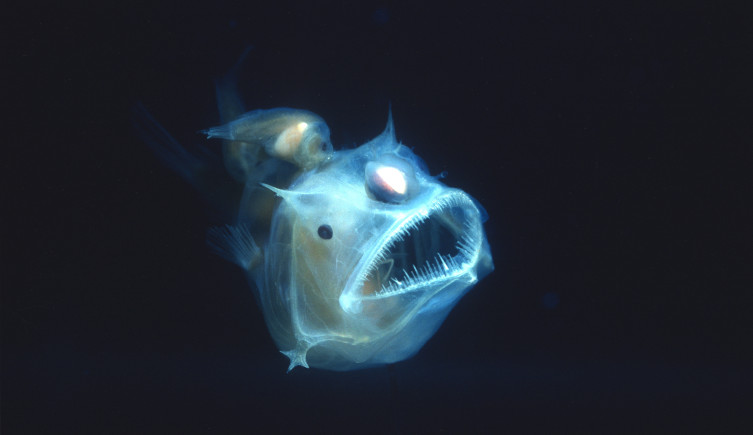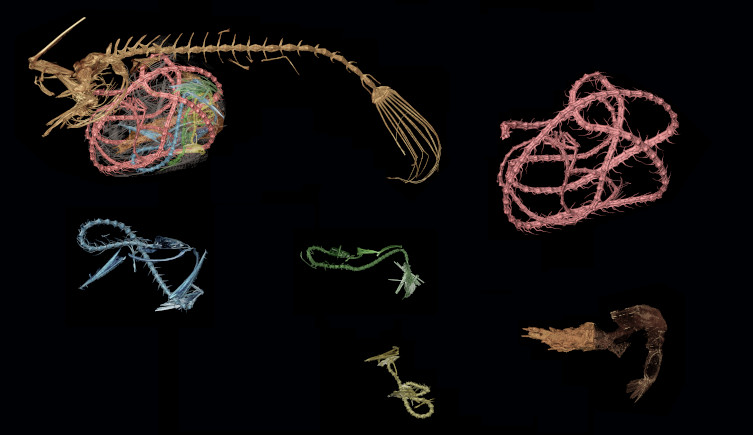The mystery of the whipnose anglerfish’s extraordinarily long lure might have finally been solved.
Swimming upside down, the fish use their lures like a fishing line to attract prey before moving in for the kill.

While the whipnose anglerfish has previously been seen upside down before, this was thought to be the exception, rather than the rule. Image © JAMSTEC.
The mystery of the whipnose anglerfish’s extraordinarily long lure might have finally been solved.
Swimming upside down, the fish use their lures like a fishing line to attract prey before moving in for the kill.
Some deep-sea anglerfish have turned their lives upside down to survive at the bottom of the ocean.
Most anglerfish are ambush predators, waiting in the darkness for fish to approach their bioluminescent lures. However, new footage of anglerfish belonging to the genus Gigantactis suggest that at least some species are more active hunters – and all while being inverted.
Swimming upside down, these fish let their extremely long lures drift just above the sea floor. While it’s not yet been caught on camera, it’s thought the anglerfish are trying to attract animals living near the seafloor so that they can pounce.
Andrew Stewartopens in a new window, the lead author of a new paper describing the behaviour, says, ‘While this was initially quite surprising, the more we thought about it, the more logical it seemed.
‘These anglerfish appear to be targeting benthic [bottom dwelling] species, and given the shape of their snout and lure, it would make a lot of sense for them to do this. Now, the challenge is to see and film one of these anglerfish actually secure prey on camera to prove it once and for all.’
James Maclaine, an expert in anglerfish from the Natural History Museum, adds, ‘While we’ve known these anglerfish are odd, I don’t think anyone thought they would feed like this. It goes to show just how important it is to explore the deep sea and see first hand behaviours like this that we would never have predicted.’
The findings of the research were published in the Journal of Fish Biologyopens in a new window.

Only female anglerfish have lures, with males generally being much smaller. Image © Neil Bromhall.
While the more than 300 species of anglerfish all live in the inky depths of the ocean, they’re perhaps the deep-sea’s most recognisable inhabitants.
This is largely due to their bioluminescent lures, known more formally as ‘esca’, which many species use to attract prey.
These lures get their distinctive glow from the bacteria which enter the fish’s lure while they’re growing upopens in a new window, gaining a place to live in return for their light – an example of a mutually beneficial relationship known as a symbiosis.
Because of this distinctive method of hunting, most anglerfish have a pretty similar body shape. The whipnose anglerfish, however, are a bit different as their lures are much longer than their whole body.
‘The classic anglerfish is fat, round, and useless at swimming fast,’ James explains. ‘It also has with poor eyesight, and so feels for the displacement of water to know when to attack prey.’
‘These whipnose anglerfishes, however, have a much more streamlined shape, suggesting that they have a much more active lifestyle.’
While an upside down Gigantactis anglerfish was first spotted in 1999opens in a new window, the observation hadn’t been followed up on, meaning that their lifestyle remained a mystery.

Other whipnose anglerfish are known to eat many different species, as this scan of its stomach contents shows. Image © Vincent Fernandez.
Now, a research team has pored through footage from remotely operated vehicles (ROVs), discovering eight more instances of this unusual behaviour. While the fish weren’t captured, the footage suggests that this style of swimming isn’t limited to just one species of Gigantactis.
This suggests that the behaviour isn’t a one off but that it has an important purpose. The researchers think this might be keeping the anglerfish safe while hunting for prey.
‘We think they drift along upside down until prey attacks, when they flick the lure up and dart down to feed,’ Andrew explains. ‘The hinge point between the lure and the head is ahead of the mouth, allowing the lure to move out of the way.’
‘By being upside down, the lure is swept under the fish while it is lunging. If the fish was the right was up, there is a risk that the lure would get swept into the mouth and be damaged. Without an active lure, the fish would probably starve.’
What the anglerfish is actually trying to catch has yet to be confirmed. However, James has a few ideas of what they might be targeting.
‘Species like tripodfish or grenadiers are found around the deep seabed, and might be potential targets,’ he says. ‘Octopus are also a possibility, as they have previously been found in the stomach of whipnose anglerfish.’
The researchers hope that further ROV expeditions will finally catch the anglerfish in the act of hunting to confirm their findings once and for all.
‘There’s a lot we still don’t understand about whipnose anglerfish,’ James says. ‘Some species don't seem to have teeth or lures, but can still be very effective predators.’
‘Specimens can only tell us so much, so I hope one day we can catch these curious fish on camera and see what they are actually doing at the bottom of the sea.’

Just how weird can the natural world be?
Don't miss a thing
Receive email updates about our news, science, exhibitions, events, products, services and fundraising activities. We may occasionally include third-party content from our corporate partners and other museums. We will not share your personal details with these third parties. You must be over the age of 13. Privacy notice.
Follow us on social media